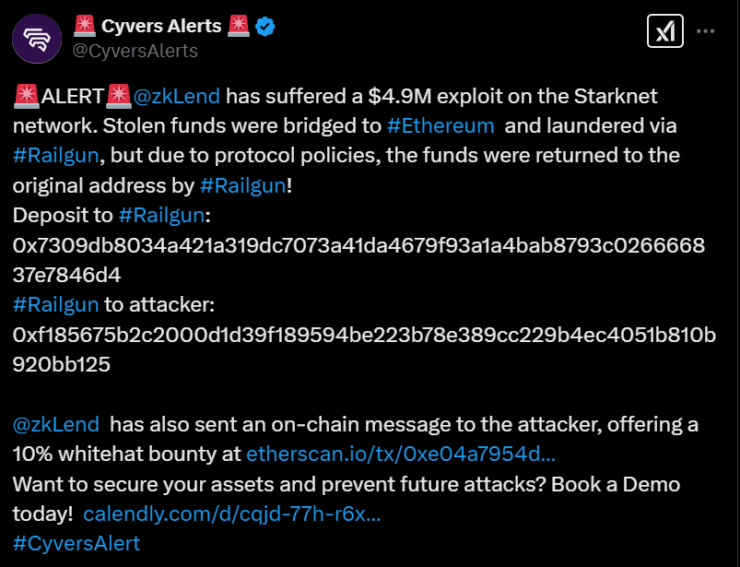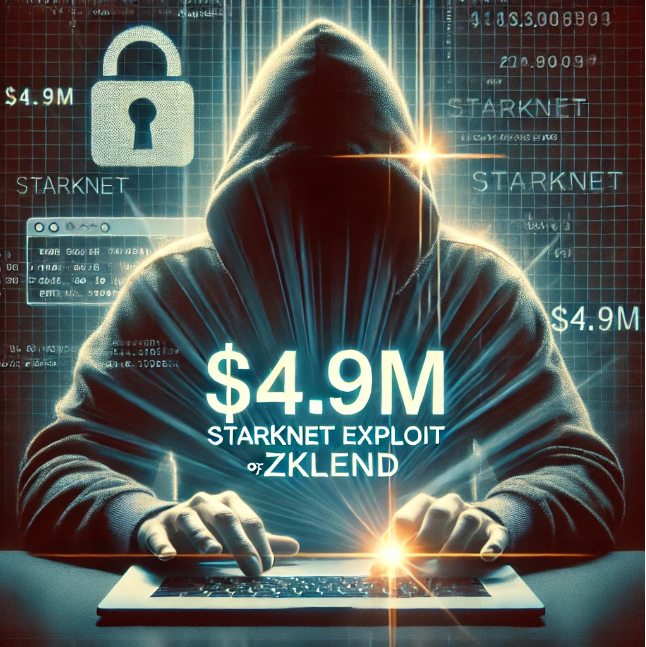A $4.9 million hack on zkLend has reignited fears over DeFi security, exposing fresh vulnerabilities in Layer 2 networks. The incident marks a resurgence in DeFi attacks, reigniting concerns about security vulnerabilities in Layer 2 ecosystems.
The Exploit: What Happened?
According to blockchain security firm Cyvers, the attack occurred on February 12, with hackers siphoning nearly 5 million USD worth of assets from zkLend. The stolen funds were bridged to Ethereum and subsequently laundered using Railgun, a privacy-preserving protocol that obfuscates transaction details.
However, due to Railgun’s internal policies, the stolen assets were returned to the original address, an unusual twist in the incident that prevented further obfuscation of the funds.

Following the exploit, zkLend publicly addressed the hacker, offering a 10% whitehat bounty in exchange for the safe return of the remaining 3,300 ETH:
“We understand that you are responsible for today’s attack on zkLend. You may keep 10% of the funds as a whitehat bounty and send back the remaining 90%, or 3,300 ETH to be exact.”
The team also issued a clear ultimatum:
“We are working with security firms and law enforcement at this stage. If we do not hear from you by 00:00 UTC, 14th Feb 2025, we will proceed with the next steps to track and prosecute you.”
Resurgence of Crypto Exploits
The zkLend hack comes at a time when the crypto industry has been struggling with persistent security breaches. Despite a 44% decrease in crypto hacks in January 2025 compared to the previous year, over $73 million was still stolen in the first month of the year.
Security experts warn that 2025 could follow the trend of previous years, with attackers exploiting DeFi vulnerabilities and smart contract loopholes to drain funds from protocols. In 2024, cybercriminals stole $2.3 billion across 165 incidents, a 40% increase over 2023, which saw $1.69 billion in stolen crypto assets.
Can Hackers Have a Change of Heart?
While most DeFi exploits result in permanent losses, there have been instances where hackers returned stolen funds, sometimes due to fear of legal action or pressure from blockchain security firms.
For example, in May 2024, an attacker returned $71 million worth of Ether following a high-profile wallet poisoning scam. The victim had accidentally sent Wrapped Bitcoin (WBTC) to a scammer’s bait address, which closely mimicked a legitimate one.
The unexpected return of funds came after multiple blockchain investigation firms tracked the attack, making it increasingly difficult for the hacker to launder the assets without consequences.
What This Means for DeFi Security
The zkLend hack raises critical questions about the security of Layer 2 protocols and the effectiveness of bounty programs as a last-resort recovery strategy. While offering a percentage of stolen funds has worked in some cases, it remains unclear if the zkLend attacker will comply or if law enforcement will have to intervene.
As DeFi adoption grows, so does the urgency to address vulnerabilities in smart contracts. The zkLend exploit serves as a stark reminder that security must remain a top priority for protocols operating in permissionless financial ecosystems.
With $4.9 million at stake, the industry will be closely watching to see if zkLend recovers its funds or if this attack becomes yet another cautionary tale in the ongoing battle against crypto exploits.





